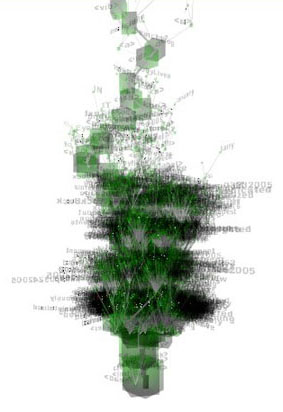
![]() This tree is made of all the pages, links and data on our site – built with a cool processing applet on texone.org (via reBlog ).
This tree is made of all the pages, links and data on our site – built with a cool processing applet on texone.org (via reBlog ).
“tree accesses the source code of a web domain through it’s url and transforms the syntactic structure of the web site into a tree structure represented by an image. this image illustrates a tree with trunk, branches and ramifications. first each tree is initialized, than all html links are detected, chronologically saved and finally displayed.”
It also builds separate trees for external links, creating entire forests of information. For some reason, our one external tree was a stubby, brown little runt for worldbook.com/info, which I’m pretty sure we do not link to, so I’ve left it off. I’m not sure why it didn’t pick up on our real external links. I’m also not sure exactly how to read the tree, but I guess I can see the basic nature of if:book represented – i.e. a blog is pretty simple structurally but with a lot of content, hence our shaggy, dense foliage on a slender trunk. I also made trees for Google and the New York Times and they were much less woolly and not green like ours.
The texone guys have also recorded the sound of data forests growing. Apparently, every node on a tree – each trunk segment, branch, and leaf – emits a piece of MIDI data – a digital note, varying in pitch according to placement on the tree (high notes are toward the top). They recorded the output for different trees and filtered it through various sound palettes (different types or arrays of instruments). A couple of examples are posted on their site. I’ve put one of them below.
if:book
A Project of the Institute for the Future of the Book

I want to booklet of different types of forest